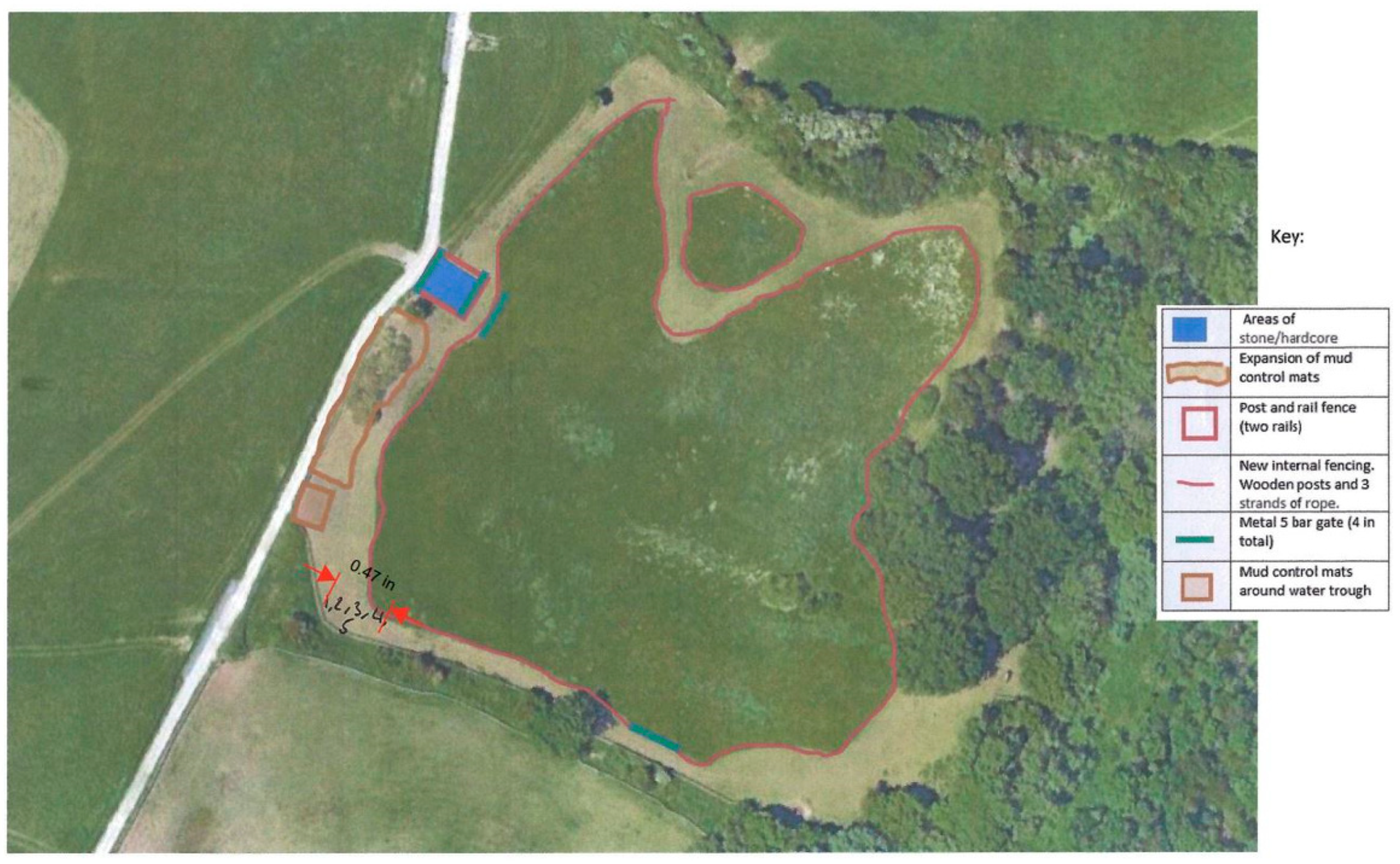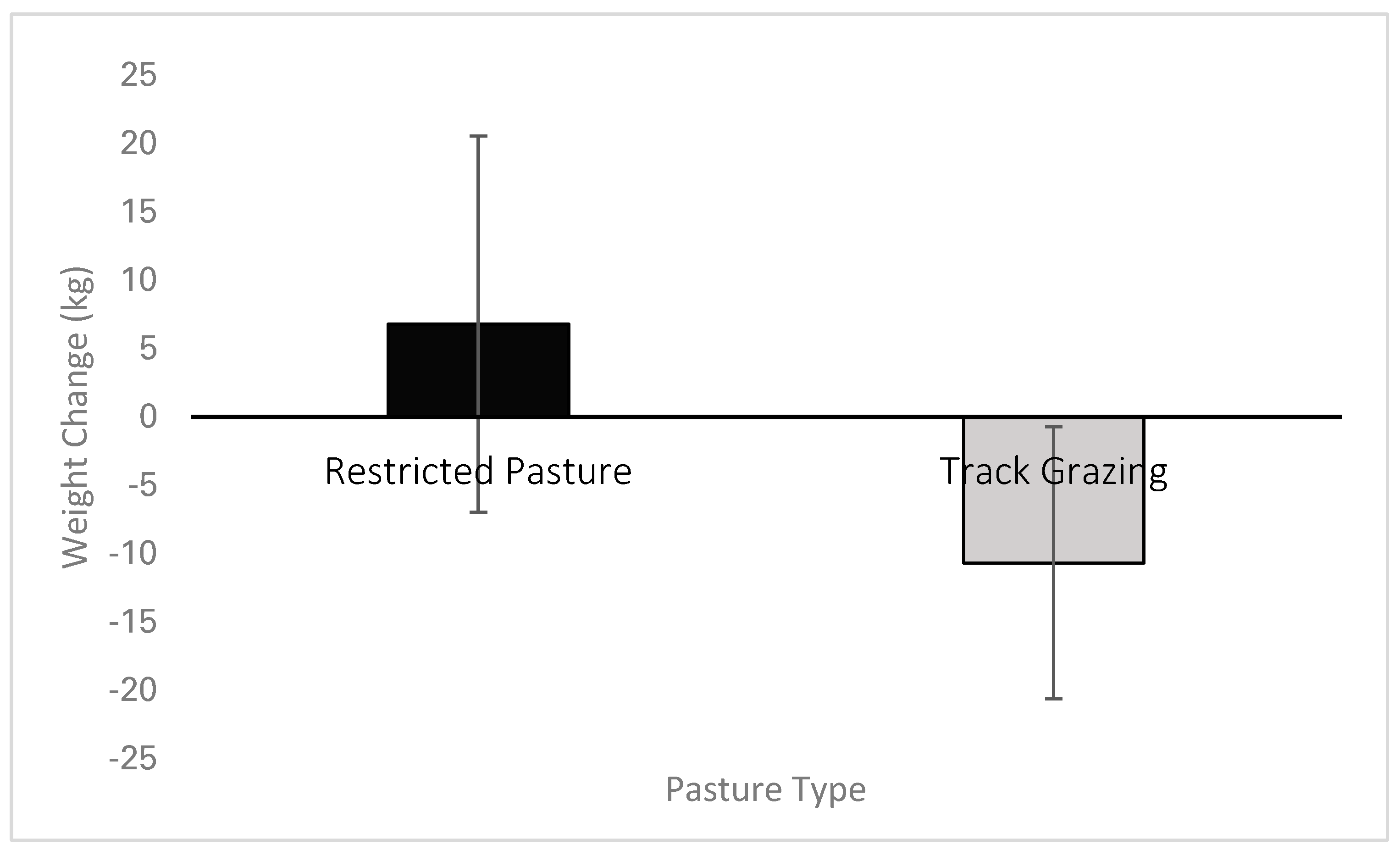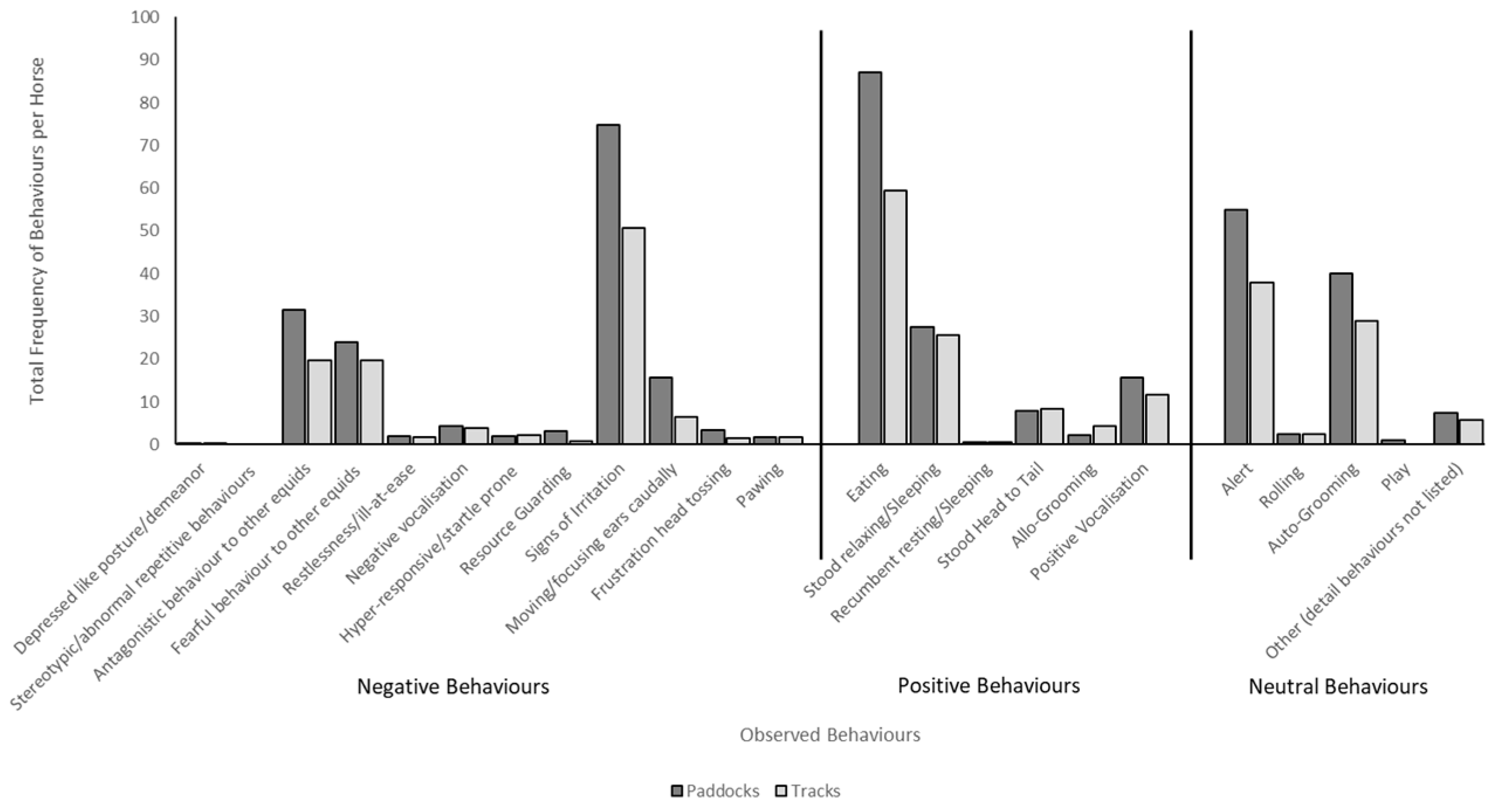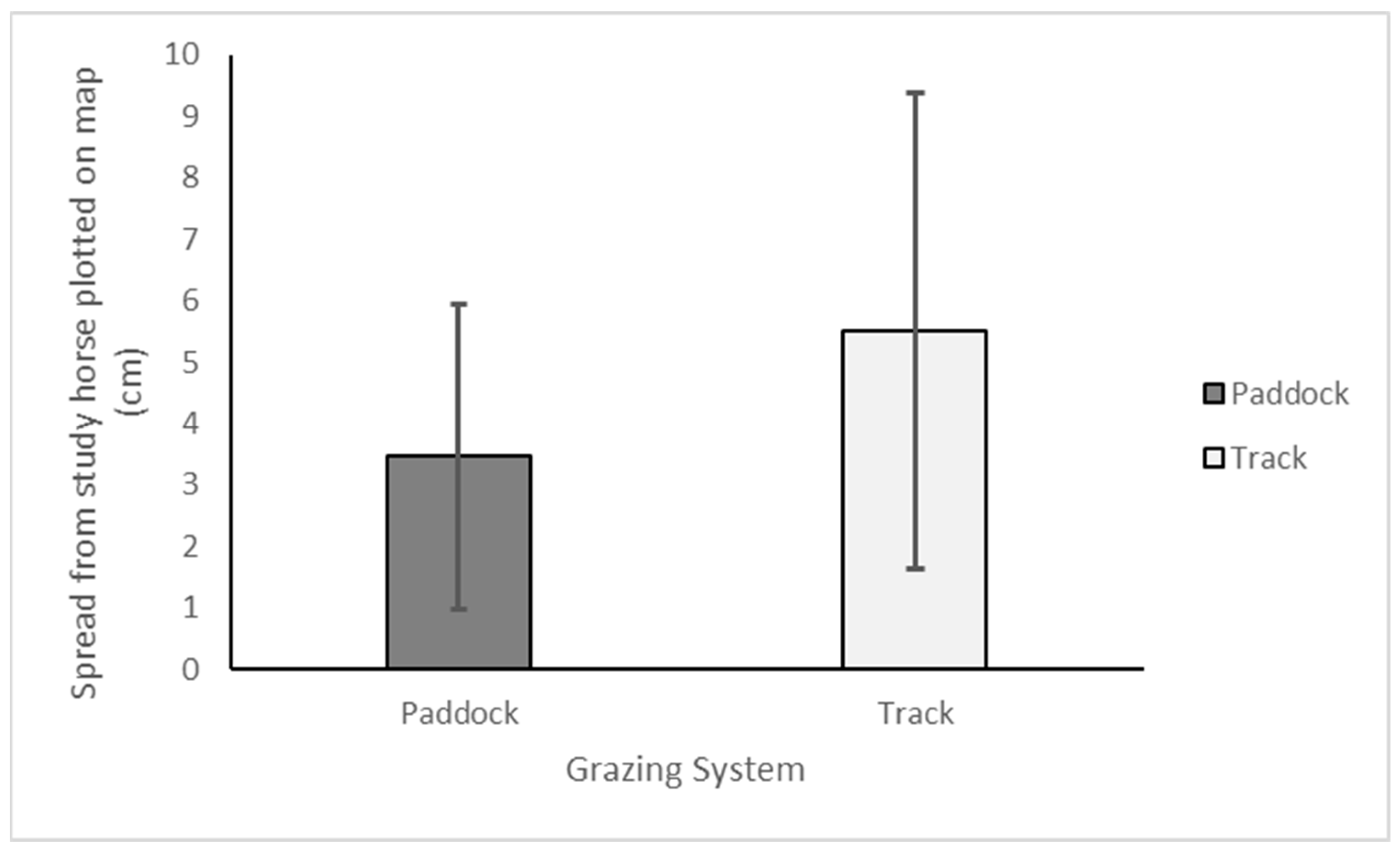Tracking the Track: The Impact of Different Grazing Strategies on Managing Equine Obesity
Simple Summary
Abstract
1. Introduction
2. Materials and Methods
2.1. Sample
2.2. Weight and Welfare Tracking
2.3. Hoof Health Tracking
2.4. Behavioural Tracking
2.5. Position Tracking
2.6. Data Analysis
3. Results
3.1. Weight and Welfare Tracking Analysis
3.1.1. Body Weight and Body Condition Score (BCS) Tracking
3.1.2. Farriery Assessment
3.2. Behavioural and Position Tracking Analysis
3.2.1. Behavioural Assessment
3.2.2. Position Assessment
4. Discussion
4.1. Management of Equine Bodyweight
4.2. Impact on Horse Equine Behaviour and Position
4.3. Further Steps
5. Conclusions
Supplementary Materials
Author Contributions
Funding
Institutional Review Board Statement
Informed Consent Statement
Data Availability Statement
Acknowledgments
Conflicts of Interest
References
- Cooper, J.J.; Mcall, N.; Johnson, S.; Davidson, H.P.B. The Short-Term Effects of Increasing Meal Frequency on Stereotypic Behaviour of Stabled Horses. Appl. Anim. Behav. Sci. 2005, 90, 351–364. [Google Scholar] [CrossRef]
- Hampson, B.A.; Morton, J.M.; Mills, P.C.; Trotter, M.G.; Lamb, D.W.; Pollitt, C.C. Monitoring distances travelled by horses using GPS tracking collars. Aust. Vet. J. 2010, 88, 176–181. [Google Scholar] [CrossRef]
- Wolter, R.; Stefanski, V.; Krueger, K. Parameters for the Analysis of Social Bonds in Horses. Animals 2018, 8, 191. [Google Scholar] [CrossRef] [PubMed]
- Ruet, A.; Lemarchand, J.; Parias, C.; Mach, N.; Moisan, M.P.; Foury, A.; Briant, C.; Lansade, L. Housing Horses in Individual Boxes Is a Challenge with Regard to Welfare. Animals 2019, 9, 621. [Google Scholar] [CrossRef]
- Bartlett, E.; Cameron, L.J.; Freeman, M.S. A Preliminary Comparison between Proximity and Interaction-Based Methods to Construct Equine (Equus caballus) Social Networks. J. Vet. Behav. 2022, 50, 36–45. [Google Scholar] [CrossRef]
- Shepherd, M.; Harris, P.; Martinson, K.L. Nutritional Considerations When Dealing with an Obese Adult Equine. Vet. Clin. N. Am.—Equine Pract. 2021, 37, 111–137. [Google Scholar] [CrossRef]
- Longland, A.C.; Barfoot, C.; Harris, P.A. Efficacy of Wearing Grazing Muzzles for 10 Hours per Day on Controlling Bodyweight in Pastured Ponies. J. Equine Vet. Sci. 2016, 45, 22–27. [Google Scholar] [CrossRef]
- Longland, A.C.; Barfoot, C.; Harris, P.A. Effects of Grazing Muzzles on Intakes of Dry Matter and Water-Soluble Carbohydrates by Ponies Grazing Spring, Summer, and Autumn Swards, as Well as Autumn Swards of Different Heights. J. Equine Vet. Sci. 2016, 40, 26–33. [Google Scholar] [CrossRef]
- Cameron, A.; Harris, P.; Longland, A.; Horseman, S.; Hockenhull, J. UK Horse Carers’ Experiences of Restricting Grazing When Aiming to Prevent Health Issues in Their Horses. J. Equine Vet. Sci. 2021, 104, 103685. [Google Scholar] [CrossRef]
- Morrison, P. Equine Obesity: Concepts and Mechanisms. Doctoral Dissertation, University of Liverpool, Liverpool, UK, 2015. Available online: https://core.ac.uk/download/pdf/80774223.pdf (accessed on 7 December 2023).
- Furtado, T.; Preshaw, L.; Hockenhull, J.; Wathan, J.; Douglas, J.; Horseman, S.; Smith, R.; Pollard, D.; Pinchbeck, G.; Rogers, J.; et al. How Happy Are Equine Athletes? Stakeholder Perceptions of Equine Welfare Issues Associated with Equestrian Sport. Animals 2021, 11, 3228. [Google Scholar] [CrossRef]
- Gill, J.C.; Pratt-Phillips, S.E.; Mansmann, R.; Siciliano, P.D. Weight Loss Management in Client-Owned Horses. J. Equine Vet. Sci. 2016, 39, 80–89. [Google Scholar] [CrossRef]
- Henneke, D.R.; Potter, G.; Kreider, J.L. Body condition during pregnancy and lactation and reproductive efficiency of mares. Theriogenology 1984, 21, 897–909. [Google Scholar] [CrossRef]
- Carroll, C.L.; Huntington, P.J. Body condition scoring and weight estimation of horses. Equine Vet. J. 1988, 20, 41–45. [Google Scholar] [CrossRef]
- Furtado, T.; King, M.; Perkins, E.; McGowan, C.; Chubbock, S.; Hannelly, E.; Rogers, J.; Pinchbeck, G. An Exploration of Environmentally Sustainable Practices Associated with Alternative Grazing Management System Use for Horses, Ponies, Donkeys and Mules in the UK. Animals 2022, 12, 151. [Google Scholar] [CrossRef]
- Hockenhull, J.; Furtado, T. Escaping the Gilded Cage: Could COVID-19 Lead to Improved Equine Welfare? A Review of the Literature. Appl. Anim. Behav. Sci. 2021, 237, 105303. [Google Scholar] [CrossRef]
- Hockenhull, J.; Creighton, E. Management Practices Associated with Owner-Reported Stable-Related and Handling Behaviour Problems in UK Leisure Horses. Appl. Anim. Behav. Sci. 2014, 155, 49–55. [Google Scholar] [CrossRef]
- Carroll, S.L.; Sykes, B.W.; Mills, P.C. An Online Survey Investigating Perceived Prevalence and Treatment Options for Stereotypic Behaviours in Horses and Undesirable Behaviours Associated with Handling and Riding. Equine Vet. Educ. 2020, 32, 71–81. [Google Scholar] [CrossRef]
- Chaya, L.; Cowan, E.; McGuire, B. A Note on the Relationship between Time Spent in Turnout and Behaviour during Turnout in Horses (Equus caballus). Appl. Anim. Behav. Sci. 2006, 98, 155–160. [Google Scholar] [CrossRef]
- Fureix, C.; Bourjade, M.; Henry, S.; Sankey, C.; Hausberger, M. Exploring Aggression Regulation in Managed Groups of Horses Equus caballus. Appl. Anim. Behav. Sci. 2012, 138, 216–228. [Google Scholar] [CrossRef]
- Gartland, B.; Strunk, W.; Schulte, B.; DeGraves, F.; Koostra, J. Time Budgets Differ in Horses during Continuous and Space-Restricted Rotational Grazing. Vet. Anim. Sci. 2024, 25, 100371. [Google Scholar] [CrossRef]
- Akinniyi, O.O.; Sackey, A.K.B.; Ochube, G.E.; Mshelia, P.W.; Jolayemi, K.O. Definition, Assessment, Health Consequences and Management of Equine Obesity: A Review. Folia Vet. 2023, 67, 1–10. [Google Scholar] [CrossRef]
- Catandi, G.D.; Fresa, K.J.; Cheng, M.H.; Whitcomb, L.A.; Broeckling, C.D.; Chen, T.W.; Chicco, A.J.; Carnevale, E.M. Follicular Metabolic Alterations Are Associated with Obesity in Mares and Can Be Mitigated by Dietary Supplementation. Sci. Rep. 2024, 14, 7571. [Google Scholar] [CrossRef] [PubMed]
- Hallman, I.; Karikoski, N.; Kareskoski, M. The Effects of Obesity and Insulin Dysregulation on Mare Reproduction, Pregnancy, and Foal Health: A Review. Front. Vet. Sci. 2023, 10, 1180622. [Google Scholar] [CrossRef]
- Menzies-Gow, N.J.; Harris, P.A.; Elliott, J. Prospective Cohort Study Evaluating Risk Factors for the Development of Pasture-Associated Laminitis in the United Kingdom. Equine Vet. J. 2017, 49, 300–306. [Google Scholar] [CrossRef] [PubMed]
- Glunk, E.C.; Pratt-Phillips, S.E.; Siciliano, P.D. Effect of restricted pasture access on pasture dry matter intake rate, dietary energy intake, and fecal pH in horses. J. Equine Vet. Sci. 2013, 33, 421–426. [Google Scholar] [CrossRef]
- Lesimple, C. Indicators of Horse Welfare: State-of-the-Art. Animals 2020, 10, 294. [Google Scholar] [CrossRef] [PubMed]
- Kirton, R.; Sandford, I.; Raffan, E.; Hallsworth, S.; Burman, O.H.; Morgan, R. The impact of restricted grazing systems on the behaviour and welfare of ponies. Equine Vet. J. 2024, 1–8. [Google Scholar] [CrossRef]
- Al-Ansari, A.S.; Golding, E.; Walshe, N.; Mooney, C.T.; Duggan, V. Obesity and Obesity-Associated Metabolic Disease Conditions in Connemara Ponies in Ireland. Equine Vet. J. 2024, 56, 273–280. [Google Scholar] [CrossRef]
- Morrison, P.K.; Newbold, C.J.; Jones, E.; Worgan, H.J.; Grove-White, D.H.; Dugdale, A.H.; Barfoot, C.; Harris, P.A.; Argo, C.M.G. The Equine Gastrointestinal Microbiome: Impacts of Age and Obesity. Front. Microbiol. 2018, 9, 3017. [Google Scholar] [CrossRef]
- Hernandez-Jover, M.; Randle, H.; Manyweathers, J.; Furtado, T. Exploring Human Behavior Change in Equine Welfare: Insights from a COM-B Analysis of the UK’s Equine Obesity Epidemic. Front. Vet. Sci. 2022, 9, 961537. [Google Scholar] [CrossRef]
- Torcivia, C.; McDonnell, S. Equine discomfort ethogram. Animals. 2021, 11, 580. [Google Scholar] [CrossRef]
- Sarrafchi, A.; Blokhuis, H.J. Equine stereotypic behaviors: Causation, occurrence, and prevention. J. Vet. Behav. 2013, 8, 386–394. [Google Scholar] [CrossRef]
- McDonnell, S.M.; Haviland, J.C. Agonistic ethogram of the equid bachelor band. Appl. Anim. Behav. Sci. 1995, 43, 147–188. [Google Scholar] [CrossRef]
- Ransom, J.I.; Cade, B.S. Quantifying Equid Behavior—A Research Ethogram for Free Roaming Feral Horses; Publications of the US Geological Survey: Lincoln, RI, USA, 2009; p. 26. Available online: https://digitalcommons.unl.edu/usgspubs/26 (accessed on 12 February 2024).
- Maigrot, A.L.; Hillmann, E.; Anne, C.; Briefer, E.F. Vocal expression of emotional valence in Przewalski’s horses (Equus przewalskii). Sci. Rep. 2017, 7, 8779. [Google Scholar] [CrossRef] [PubMed]
- Lundberg, P.; Hartmann, E.; Roth, L.S. Does training style affect the human-horse relationship? Asking the horse in a separation–reunion experiment with the owner and a stranger. Appl. Anim. Behav. Sci. 2020, 233, 105144. [Google Scholar] [CrossRef]
- McDonnell, S.M. The Equid Ethogram: A Practical Field Guide to Horse Behavior; Eclipse Press: Liverpool, UK, 2003. [Google Scholar]
- Schork, I.G.; de Azevedo, C.S.; Young, R.J. Personality, abnormal behaviour, and health: An evaluation of the welfare of police horses. PLoS ONE 2018, 13, e0202750. [Google Scholar] [CrossRef]
- McDonnell, S.M.; Poulin, A. Equid play ethogram. Appl. Anim. Behav. Sci. 2002, 78, 263–290. [Google Scholar] [CrossRef]
- Stomp, M.; Leroux, M.; Cellier, M.; Henry, S.; Lemasson, A.; Hausberger, M. An unexpected acoustic indicator of positive emotions in horses. PLoS ONE. 2018, 13, e0197898. [Google Scholar] [CrossRef]
- Laurijs, K.A.; Briefer, E.F.; Reimert, I.; Webb, L.E. Vocalisations in farm animals: A step towards positive welfare assessment. Appl. Anim. Behav. Sci. 2021, 236, 105264. [Google Scholar] [CrossRef]
- Hartmann, E.; Christensen, J.W.; McGreevy, P.D. Dominance and leadership: Useful concepts in human–horse interactions? J. Equine Vet. Sci. 2017, 1, 1–9. [Google Scholar] [CrossRef]
- Pratt-Phillips, S. Effect of Exercise Conditioning on Countering the Effects of Obesity and Insulin Resistance in Horses—A Review. Animals. 2024, 14, 727. [Google Scholar] [CrossRef] [PubMed]
- Phelipon, R.; Hennes, N.; Ruet, A.; Bret-Morel, A.; Górecka-Bruzda, A.; Lansade, L. Forage, freedom of movement, and social interactions remain essential fundamentals for the welfare of high-level sport horses. Front. Vet. Sci. 2024, 20, 1504116. [Google Scholar] [CrossRef] [PubMed]
- Mellor, D.J.; Beausoleil, N.J.; Littlewood, K.E.; McLean, A.N.; McGreevy, P.D.; Jones, B.; Wilkins, C. The 2020 five domains model: Including human–animal interactions in assessments of animal welfare. Animals 2020, 10, 1870. [Google Scholar] [CrossRef] [PubMed]






| Field | Horse | Sex | Breed | Age (Years) | Height (cm) | Known Health Conditions/Management |
|---|---|---|---|---|---|---|
| Track A | 1 | Mare | Cob | 11 | 143.26 | Prone to weight gain |
| 2 | Gelding | Cob | 9 | 121.92 | Prone to weight gain | |
| 3 | Mare | Welsh Sec A | 16 | 111.76 | Prone to weight gain | |
| 4 | Mare | Cob | 4 | 113.79 | Prone to weight gain | |
| 5 | Mare | Cob | 3 | 123.95 | Prone to weight gain | |
| 6 | Mare | Welsh Sec A | 13 | 114.8 | Prone to weight gain | |
| Track B | 7 | Mare | Shetland | 7 | 81.28 | None |
| 8 | Mare | Shetland | 9 | 91.44 | Partially collapsed trachea - limited exercise options for weight management | |
| 9 | Mare | Shetland | 14 | 91.44 | Laminitis and pituitary pars intermedia dysfunction | |
| Track C | 10 | Mare | New Forest x | 26 | 134.11 | Laminitis, pituitary pars intermedia dysfunction and asthma |
| 11 | Mare | TB x Trotter | 22 | 134.11 | Laminitis | |
| 12 | Gelding | Welsh Sec B | 14 | 122.94 | Laminitis and prone to weight loss | |
| 13 | Mare | Welsh x | 21 | 132.08 | Equine metabolic syndrome | |
| Paddock D | 14 | Gelding | Cob x Trotter | 8 | 152.4 | Prone to weight gain |
| 15 | Gelding | Cob x | 15 | 162.56 | Navicular and asthma | |
| Paddock E | 16 | Gelding | Shetland | 11 | 91.44 | Prone to weight gain |
| 17 | Gelding | Shetland x Cob | 20 | 111.76 | Prone to weight gain | |
| Paddock F | 18 | Mare | New Forest x | 21 | 142.24 | Laminitis, breathing issues |
| 19 | Mare | Cob x | 14 (estimated) | 142.24 | Laminitis and prone to weight loss |
| Behaviour | Description | Behaviour Category |
|---|---|---|
| Depressed like posture/demeanour | Less responsive to the environment than what is normal for that horse. Often with a ‘zoned out’, worried, or glassy-eyed staring facial expression [32]. | Negative |
| Stereotypies/Abnormal Repetitive Behaviours | Including abbreviated weaving, nose tossing/flipping, head bobbing, frequent yawning bouts, sympathetic surge resolution signs, crib biting, wind sucking, and lip smacking [32,33]. | Negative |
| Antagonistic Behaviour to other Equids | Behaviour observed including—Bite threat, biting, bump/pushing, rearing, chasing, ears pinned, head threat, kick threat, kicking, or herding [34]. Descriptions of each:
| Negative |
| Fearful Behaviour to other Equids | Exhibited by the loser of the antagonistic encounter. May be expressed by running away, laid down ears, lowered head posture, lowering of the hind quarters, and sometimes jaw snapping (however often only observed in juveniles). Submissive behaviour [35]. | Negative |
| Restlessness/Ill-at-ease | Including changing activities frequently (foraging, standing rest, standing alert) more often than would be expected, circling/pacing, fidgeting, frequent repositioning during recumbency, or abandoning recumbency/elimination attempt [32]. | Negative |
| Negative Vocalisation | Including groaning, sighing, grunting, screaming/calling, and teeth grinding. Squeals have been noted to be produced in agonistic reactions [32,36]. | Negative |
| Hyper-Responsive/Startle Prone | Lower threshold and more animated reaction to environmental stimuli [32]. | Negative |
| Signs of irritation | Often seen due to insects. Swishing/flicking tail—moving the tail suddenly from side to side [32]. Swatting/batting—swinging the head and neck at a particular area of the body [32]. | Negative |
| Moving/Focusing Ears Caudally | Moving the ears to focus backwards or laying the ears back against the neck [32]. | Negative |
| Frustration Head Tossing | Quick rotational toss of the head, similar to a head threat [32]. | Negative |
| Pawing | Front leg is lifted, then extended quickly in a forward direction, followed by a movement backward dragging the toe against the ground in a digging motion [37]. | Negative |
| Eating | Grazing—Ingest grassy vegetation. With the lips and tongue, vegetation is gathered into the mouth, broken off usually in clumps by jerking the jaw while chewing, and swallowed [38]. Browse—Ingest woody plants [38]. | Positive |
| Stood Relaxing/Sleeping |
| Positive |
| Recumbent Relaxing/Sleeping | Positive | |
| Alert | Standing still with head high, ears pointing forward. Nostrils may or may not be dilated [39]. | Neutral |
| Allo-Grooming | Lateral parallel body position of two horses that allows for nibbling along the back or withers of each horse [35]. | Positive |
| Auto-Grooming | Nibbling, nuzzling, and/or biting at an area of the body, or rubbing one part of the body to another or against an object [32]. | Neutral |
| Play | Consists of several behaviours categorised by object play, sexual behaviour, locomotor play, and play fighting [40].
| Neutral |
| Stood Head to Tail | Can also be characterised as huddling. Provides physical protection as well as being a resting behaviour and allowing for insect control around the head by tail swishing effect of neighbours [35]. | Positive |
| Rolling | Laying down to sternal recumbency, rotating from sternal to lateral, onto dorsal recumbency [32]. | Neutral |
| Positive Vocalisation | Snorts and shorter, lower frequency whinny. And nickers [36,41,42]. | Positive |
| Resource Guarding | Management conditions where available resources such as food are restricted, small enclosure sizes, and/or high density of horses and unstable group membership are usually associated with higher aggression levels, and guarding of available resources [43]. | Negative |
| Other | Any behaviour that has not been listed previously. | Neutral |
| Grazing Area Information | ||||
|---|---|---|---|---|
| Field | Perimeter (m) | Total Area (Acres) | Area Available for Grazing (Acres) | Incline |
| Track A | 551.87 | 4 | 1.82 | Very steep on sides |
| Track B | 476.89 | 3 | 0.77 | Very slight |
| Track C | 383.92 | 2 | 0.45 | Flat |
| Paddock D | 594.68 | 4 | 3.98 | Flat |
| Paddock E | 708.97 | 8 | 7.24 | Flat |
| Paddock F | 414.63 | 2 | 1.99 | Flat |
Disclaimer/Publisher’s Note: The statements, opinions and data contained in all publications are solely those of the individual author(s) and contributor(s) and not of MDPI and/or the editor(s). MDPI and/or the editor(s) disclaim responsibility for any injury to people or property resulting from any ideas, methods, instructions or products referred to in the content. |
© 2025 by the authors. Licensee MDPI, Basel, Switzerland. This article is an open access article distributed under the terms and conditions of the Creative Commons Attribution (CC BY) license (https://creativecommons.org/licenses/by/4.0/).
Share and Cite
Cameron, L.; Challinor, M.; Armstrong, S.; Kennedy, A.; Hollister, S.; Fletcher, K. Tracking the Track: The Impact of Different Grazing Strategies on Managing Equine Obesity. Animals 2025, 15, 874. https://doi.org/10.3390/ani15060874
Cameron L, Challinor M, Armstrong S, Kennedy A, Hollister S, Fletcher K. Tracking the Track: The Impact of Different Grazing Strategies on Managing Equine Obesity. Animals. 2025; 15(6):874. https://doi.org/10.3390/ani15060874
Chicago/Turabian StyleCameron, Lorna, Meg Challinor, Sophie Armstrong, Abigale Kennedy, Sarah Hollister, and Katharine Fletcher. 2025. "Tracking the Track: The Impact of Different Grazing Strategies on Managing Equine Obesity" Animals 15, no. 6: 874. https://doi.org/10.3390/ani15060874
APA StyleCameron, L., Challinor, M., Armstrong, S., Kennedy, A., Hollister, S., & Fletcher, K. (2025). Tracking the Track: The Impact of Different Grazing Strategies on Managing Equine Obesity. Animals, 15(6), 874. https://doi.org/10.3390/ani15060874





